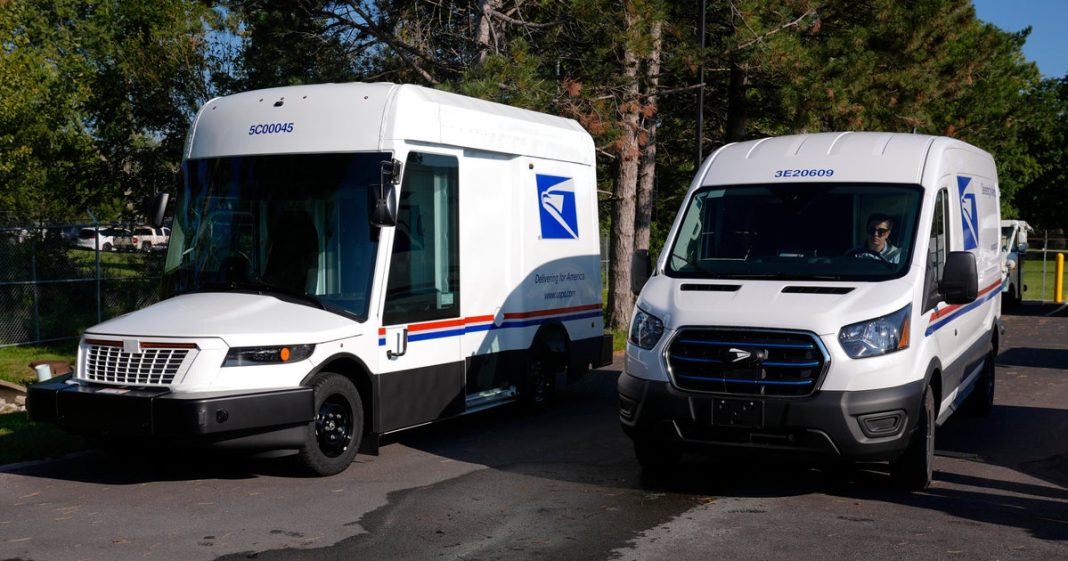Last September, the U.S. Postal Service debuted its long-awaited — and much litigated — electric vehicle mail delivery truck. Since then, more than 7,200 new zero-emissions vehicles have been distributed to the Postal Service.
But a provision tucked inside the Senate Republican bill to enact President Trump’s second-term agenda would force the USPS to sell off the brand new trucks and cancel or significantly amend the contract for the remaining 58,800 that are due to be delivered over the next 10 years.
Michael Conroy / AP
According to the text of the Homeland Security and Governmental Affairs portion of the bill released by Kentucky GOP Senator Rand Paul, chair of the committee, all electric vehicles and related infrastructure owned by the Postal Service will be sold and the proceeds will “be deposited into the general fund of the treasury.” Selling the EVs would “cut unnecessary costs and focus USPS on delivering mail and not achieving the environmental initiatives pushed by the Biden Administration,” according to the bill.
Paul’s office didn’t immediately respond to a request for comment.
Peter Pastre, the vice president of government relations and public policy for USPS, wrote a letter to the Senate in June that said the provision to sell the EVs would “make major and damaging changes to the U.S. Postal Service’s vehicle fleet program, potentially impacting our ability to deliver to millions of Americans.”
The bill is being considered under budget reconciliation rules, which means that Republicans can pass it with a simple majority, instead of meeting the 60-vote threshold that is required to consider most Senate legislation. In order to use this approach, every item in the bill must have a budgetary impact, and the Senate parliamentarian determines whether each provision meets that standard, known as the Byrd Rule.
Senate parliamentarian Elizabeth MacDonough found that disposing of the USPS EVs is one of several of the bill’s provisions violating the Byrd Rule, according to Senate Democrats.
Republicans, who would like to revoke the EVs and their related infrastructure, say this provision could potentially raise money by rescinding $1 billion allocated in the Biden-era Inflation Reduction Act to purchase the vehicles. But according to Pastre, it would cost more than $450 million to replace the 7,200 revoked vehicles, and the USPS has already spent more than $540 million on electrical upgrades for infrastructure to support the cars.
Because the majority of the vehicles are specially designed for the Postal Service — like right-side driving for mail delivery trucks — and most of the electrical infrastructure is buried under ground, the potential for raising money at auction is “negligible,” according to Pastre.
Pastre was direct about the harm this action would cause the Postal Service saying, “it will seriously cripple our ability to replace an aging and obsolete delivery fleet.”
“The Postal Service has over 200,000 vehicles in an outdated and aging fleet. Using EVs will reduce fuel and maintenance costs and help the USPS to better serve the public,” Mark Dimondstein, president of American Postal Workers Union, said in an email to CBS News. “Eliminating energy-efficient vehicles would be a step backward and not be in the best interest of those we serve and the communities where we live.”
Since 2015, the USPS has been looking to update and modernize its fleet of more than 200,000 vehicles. The majority of the trucks were 25 years old or more, often lacked proper heating and cooling and in some cases, would spontaneously combust in neighborhoods as workers operated the aging vehicles.
When the Postal Service first announced its proposal in 2021 to replace 165,000 vehicles, it originally intended to purchase traditional gas vehicles to replace 90% of the fleet. But the gas-powered mail trucks had low fuel efficiency, guzzling fuel at under a 9-m.p.g. rate, according to filings by several environmental organizations and more than a dozen states that sued to block the plan.
“It’s important that EVs be part of the mix for the USPS because it should represent the next generation,” said Dan Becker, director of the Safe Climate Transport Campaign at the Center for Biological Diversity, one of the organizations that sued the USPS in 2021. “The last generation of vehicles are literally dying on its wheels.”
The legal action forced the USPS to reconsider its plan, and it finalized a deal in late 2022 to purchase 106,000 new cars — and 66,000 were to be zero-emissions vehicles. It also planned to install more than 14,000 chargers to keep the fleet running. The cost to update the fleet totaled $9.6 billion, and the Biden administration allocated $3 billion from the Inflation Reduction Act to help cover the costs, with the rest financed by the Postal Service.
“My bet is this will survive another day,” said Becker, given that the parliamentarian has ruled it should be stricken and it would be difficult to get 60 votes in the Senate to keep it in the bill. But Congress recently voted to revoke California’s EPA waivers to enact its EV mandate under the Congressional Review Act, which the parliamentarian said was illegal. It remains to be seen if Republicans will follow her recommendations.
“Selling them off at a discount just so you don’t have to say you don’t have EVs for political reasons makes no sense,” said Becker.




